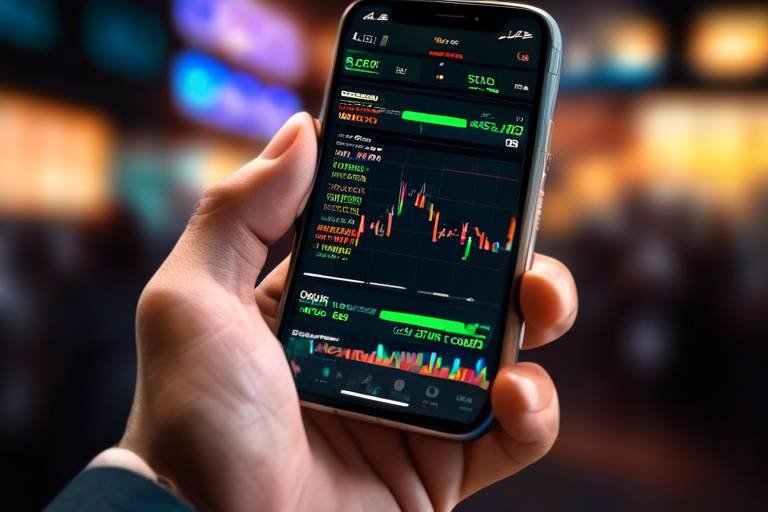Exploring the Scalping Strategy in Cryptocurrency Markets
In the fast-paced world of cryptocurrency trading, where prices can swing wildly in a matter of seconds, traders are constantly on the lookout for strategies that can help them capitalize on these movements. One such strategy that has gained significant traction is scalping. But what exactly is scalping, and why has it become a popular choice among traders? This article delves into the intricacies of the scalping strategy, examining its core principles, benefits, risks, and practical applications for those eager to optimize their investment strategies.
At its core, scalping is a trading strategy designed to make small profits from numerous trades throughout the day. Think of it as a game of catch, where traders throw small amounts of capital into the market, hoping to catch tiny price movements. These trades are typically executed over very short timeframes—often just minutes or even seconds. The appeal of scalping lies in its potential for quick returns and the ability to leverage market volatility. Traders can use various techniques, including technical analysis and chart patterns, to identify entry and exit points, allowing them to make informed decisions in real-time.
Scalping offers a multitude of advantages that make it an attractive strategy for active traders in the cryptocurrency space. One of the most significant benefits is the ability to realize profits quickly. Unlike long-term investing, where gains may take weeks or months to materialize, scalpers can see returns almost immediately. This rapid profit realization not only boosts a trader's confidence but also allows for reinvestment into more trades, compounding potential earnings.
Another key advantage is the reduced exposure to market volatility. Since scalpers hold positions for such short durations, they are less susceptible to the dramatic price swings that can occur in the cryptocurrency markets. This means that while the market may be experiencing turbulence, scalpers can still make profitable trades without being overly affected by the broader market trends.
One of the appealing aspects of scalping is its low capital requirement. Many traders believe that significant investment is necessary to achieve success in trading, but scalping proves otherwise. With the right strategy and tools, individuals can engage in scalping with minimal investment. This accessibility opens the door for a broader audience, allowing more people to participate in the cryptocurrency market without needing deep pockets.
Utilizing leverage can significantly amplify gains in scalping, but it comes with its own set of risks. Leverage allows traders to control larger positions than their initial capital would typically permit, potentially leading to higher profits from small price movements. However, it’s essential to use leverage wisely. If the market moves against a leveraged position, losses can also be magnified. Therefore, effective risk management is crucial for successful scalping.
The inherent volatility of cryptocurrency markets creates a plethora of frequent trading opportunities for scalpers. Unlike traditional markets, where price movements may be slower, cryptocurrencies can experience rapid fluctuations. This volatility means that scalpers can capitalize on numerous opportunities throughout the day, making it possible to execute multiple trades and increase overall profitability. However, it’s essential for traders to stay alert and responsive to market changes, as the window for profitable trades can be incredibly brief.
Despite its benefits, scalping is not without risks. One major concern is the transaction costs associated with frequent trading. Each trade incurs fees, and these can quickly add up, eating into profits. Traders must carefully consider their trading volume and the fee structure of their chosen platform to ensure that they remain profitable.
Additionally, the emotional stress of rapid trading can be overwhelming. The need to make quick decisions and react to market movements can lead to impulsive trading, which often results in losses. Therefore, maintaining a disciplined approach and sticking to a well-defined trading plan is essential for success.
To effectively implement a scalping strategy, traders require specific tools and resources. The right platforms, indicators, and technologies can significantly enhance a trader's performance in the fast-paced cryptocurrency markets.
Choosing the right trading platform is crucial for scalpers. Popular platforms that cater to scalping needs often feature low fees, high liquidity, and advanced trading tools. Some of the well-regarded platforms include:
- Binance: Known for its extensive range of trading pairs and low fees.
- Kraken: Offers advanced charting tools and high security.
- Bitfinex: Provides a user-friendly interface and margin trading options.
Technical indicators play a vital role in scalping strategies. By analyzing price trends and patterns, traders can identify optimal entry and exit points. Some of the most effective indicators for scalping include:
- Moving Averages: Helps smooth out price data and identify trends.
- Relative Strength Index (RSI): Indicates overbought or oversold conditions.
- Bollinger Bands: Provides insights into price volatility and potential reversals.
What is the best time frame for scalping?
Scalpers typically use very short time frames, such as 1-minute or 5-minute charts, to make quick trades based on small price movements.
Can I scalp with a small investment?
Yes, one of the advantages of scalping is that it allows traders to engage with minimal capital, making it accessible for many.
What are the risks of scalping?
Risks include transaction costs, emotional stress, and the potential for significant losses if trades go against you, especially when using leverage.
How can I improve my scalping strategy?
Continuous learning, practicing on demo accounts, and utilizing the right tools and indicators can help improve your scalping strategy.

Understanding Scalping
Scalping is a trading strategy that has gained immense popularity in the fast-paced world of cryptocurrency markets. But what exactly does it mean? At its core, scalping involves making numerous small trades throughout the day to capture tiny price movements. Think of it like a fisherman casting a net multiple times, hoping to catch little fish rather than waiting for the big one to bite. This approach allows traders to realize profits quickly, often within minutes or even seconds, making it particularly appealing in the volatile landscape of cryptocurrencies.
One of the defining characteristics of scalping is the timeframe in which trades are executed. Scalpers typically operate on very short timeframes, ranging from a few seconds to several minutes. This rapid trading style requires a keen eye and the ability to make split-second decisions. The goal is to capitalize on brief fluctuations in price, which are common in the cryptocurrency market due to its inherent volatility. For instance, a scalper may buy Bitcoin at $30,000 and sell it just moments later at $30,100, pocketing a quick profit of $100. While these profits may seem small individually, they can add up significantly when executed repeatedly throughout the day.
To be effective at scalping, traders often rely on specific techniques and tools. These can include the use of technical analysis, which involves studying price charts and indicators to identify potential entry and exit points. Scalpers may use indicators such as Moving Averages, Bollinger Bands, or the Relative Strength Index (RSI) to make informed decisions. Additionally, managing risk is crucial; scalpers often set tight stop-loss orders to protect their investments from sudden market reversals.
Moreover, the appeal of scalping in the cryptocurrency market can be attributed to its low capital requirement. Unlike traditional investing strategies that may necessitate a large initial investment, scalping can be started with a relatively modest amount of capital. This democratizes trading, allowing a broader audience to participate in the market. However, while the entry barrier is low, the need for discipline, quick thinking, and emotional control remains high.
In summary, scalping is a dynamic and exciting trading strategy that offers the potential for quick profits in the ever-changing cryptocurrency landscape. With the right tools, techniques, and mindset, traders can navigate the turbulent waters of the market, making the most of every small price movement. As we delve deeper into the benefits and risks of this strategy, it becomes clear that while scalping can be rewarding, it also requires a thorough understanding of market dynamics and a commitment to continuous learning.

Benefits of Scalping
Scalping is like a high-speed chase in the world of cryptocurrency trading, where the thrill lies in making quick profits from tiny price movements. One of the most enticing aspects of this strategy is its ability to offer rapid returns on investment. Instead of waiting for long-term gains, scalpers aim to grab those little profit nuggets throughout the day. Imagine catching a wave while surfing; the key is to ride it just long enough to enjoy the thrill but not so long that you wipe out. This approach is especially beneficial in the volatile cryptocurrency markets, where price swings can happen in the blink of an eye.
Another significant advantage of scalping is the reduced exposure to market volatility. Since trades are executed quickly, scalpers typically hold positions for mere minutes or even seconds. This minimizes the risk associated with sudden market downturns. For instance, if you buy Bitcoin at $30,000 and sell it at $30,100 just minutes later, you’ve secured your profit before any potential downturn can affect your position. This strategy can be particularly useful during periods of high market unpredictability, allowing traders to sidestep the emotional rollercoaster that often accompanies long-term investments.
Moreover, scalping can be accessible to a wide range of traders due to its low capital requirement. Unlike traditional investing, which often necessitates a hefty sum to make a meaningful profit, scalping allows individuals to start with a smaller investment. This democratization of trading means that even those with limited funds can participate in the action. Think of it as entering a race where you don’t need a fancy car to compete; you just need to be quick on your feet and know the right moves.
Utilizing leverage is another compelling aspect of scalping. Many trading platforms allow scalpers to borrow funds to increase their trading positions, effectively amplifying their potential gains. However, it’s crucial to wield this double-edged sword with caution. While leverage can enhance profits, it can also magnify losses. Therefore, understanding how to use leverage responsibly is key to maintaining a sustainable scalping strategy. A well-calibrated approach can turn a small amount of capital into substantial profits, as long as traders remain disciplined and vigilant.
Lastly, the fast-paced nature of scalping creates frequent trading opportunities. In the cryptocurrency market, prices can fluctuate dramatically within short timeframes, presenting scalpers with numerous chances to enter and exit trades. This constant movement is akin to a bustling marketplace where opportunities are ripe for the picking. By staying alert and utilizing effective technical analysis, traders can identify patterns and trends that signal the best times to make their moves. The thrill of capturing these fleeting opportunities can be exhilarating, making scalping not just a strategy but a lifestyle for many active traders.
- What is the best time frame for scalping? Scalpers typically operate on very short time frames, often using 1-minute to 5-minute charts to make quick trades.
- Is scalping suitable for beginners? While scalping can be accessible, it requires a solid understanding of market mechanics and quick decision-making, so beginners should practice extensively before diving in.
- What tools do I need for scalping? Essential tools include a reliable trading platform, real-time market data feeds, and technical indicators to help identify trading opportunities.

Low Capital Requirement
One of the most enticing aspects of the scalping strategy in cryptocurrency trading is its . Unlike traditional investing methods that often necessitate a hefty initial investment, scalping opens the door for traders with varying financial backgrounds to participate in the market. Imagine being able to dive into the world of crypto trading without needing to break the bank; that’s the beauty of scalping!
With just a modest amount of capital, traders can engage in multiple small trades throughout the day. This accessibility means that anyone with a few hundred dollars can start scalping, making it a popular choice among retail traders. The essence of scalping lies in the frequency of trades rather than the size of individual trades. For instance, if you start with $500 and execute a series of trades, each yielding a small profit, you can gradually build your portfolio without the pressure of substantial investment.
Moreover, the low capital requirement allows traders to explore and refine their strategies without risking significant sums. This is particularly important in the volatile world of cryptocurrencies, where prices can swing dramatically in a matter of minutes. By minimizing their initial investment, traders can experiment with different approaches, learning what works best for them without the fear of losing their life savings.
However, it’s crucial to understand that while low capital can be a gateway, it also comes with its own set of challenges. For example, smaller account sizes may lead to higher relative transaction costs, which can eat into profits. Therefore, traders should be mindful of the fees associated with their trading platforms. To illustrate this, consider the following table that compares potential profits against transaction costs for different capital amounts:
| Initial Capital ($) | Number of Trades | Average Profit per Trade ($) | Total Profit ($) | Transaction Costs ($) | Net Profit ($) |
|---|---|---|---|---|---|
| 500 | 50 | 5 | 250 | 100 | 150 |
| 1000 | 50 | 10 | 500 | 100 | 400 |
| 2000 | 50 | 15 | 750 | 100 | 650 |
As shown in the table, as your initial capital increases, so does your potential profit. However, the key takeaway is that even with a smaller investment, savvy traders can still find success through consistent execution of their scalping strategy. In essence, the low capital requirement of scalping democratizes trading, making it accessible to a wider audience and allowing anyone with the right mindset and strategy to potentially profit in the fast-paced world of cryptocurrency.

Leverage Use
When it comes to scalping in the cryptocurrency markets, leverage can be a double-edged sword. On one hand, it allows traders to amplify their potential gains significantly; on the other, it can also magnify losses if not managed properly. Leverage essentially means that you can control a larger position than your actual investment. For instance, with a leverage ratio of 10:1, a trader can control $10,000 worth of assets with just $1,000 of their own capital. This capability is particularly appealing in the fast-paced world of crypto trading, where price movements can happen in the blink of an eye.
However, leveraging requires a solid understanding of both the market and risk management strategies. Many traders jump into leveraged trading without fully comprehending the implications, which can lead to substantial losses. It’s crucial to set strict stop-loss orders to protect your capital. For example, if you are trading Bitcoin and decide to use leverage, you might set a stop-loss at a certain percentage below your entry price. This way, if the market moves against you, your losses will be capped, preventing a total wipeout of your account.
Moreover, using leverage effectively involves knowing when to scale in and out of positions. Scalpers often make multiple trades within a single day, taking advantage of small price fluctuations. By applying leverage judiciously, they can increase their profit margins on each trade. However, it's essential to remember that the higher the leverage, the smaller the price movement required to trigger a margin call—where the broker demands additional funds to cover potential losses. Traders should always be prepared for the possibility of sudden market shifts, especially in the notoriously volatile cryptocurrency space.
Here’s a quick overview of the pros and cons of using leverage in scalping:
| Pros | Cons |
|---|---|
| Amplified profits on successful trades | Increased risk of significant losses |
| Ability to control larger positions | Margin calls can occur rapidly |
| Potential for quick returns | Emotional stress from rapid trading |
In conclusion, leveraging can be an effective tool for scalpers looking to maximize their returns. However, it requires a careful approach, a solid trading plan, and a thorough understanding of the risks involved. Always remember that while leverage can enhance your trading strategy, it should be used responsibly and with caution.
- What is leverage in cryptocurrency trading?
Leverage in cryptocurrency trading allows traders to borrow funds to increase their trading position, potentially amplifying both gains and losses. - How does leverage affect my trading strategy?
Leverage can enhance your profit margins if used correctly, but it also increases the risk of losing more than your initial investment. - What is a margin call?
A margin call occurs when your account equity falls below the broker's required minimum, prompting them to ask for additional funds to cover potential losses.

Frequent Trading Opportunities
In the fast-paced world of cryptocurrency trading, are the lifeblood of a successful scalper. Scalping thrives on the notion that small price movements can be exploited multiple times throughout the day. Imagine a bustling marketplace where every minute, prices fluctuate like the tides—this is precisely what a scalper seeks to harness. With cryptocurrencies known for their notorious volatility, traders can find themselves in a constant dance with market movements, ready to capitalize on even the slightest shifts.
One of the most enticing aspects of scalping is the sheer number of trades that can be executed in a single day. Unlike traditional investing, where one might hold onto an asset for weeks or months, scalpers can execute dozens, if not hundreds, of trades within a 24-hour period. This high-frequency trading approach allows them to accumulate small gains that can quickly add up. For instance, consider a scenario where a trader makes 50 trades in a day, each yielding a profit of just $5. At the end of the day, that's a neat profit of $250—without needing to hold onto any asset for an extended period.
However, it’s not just about the number of trades; it’s also about the timing. Scalpers must be vigilant and ready to act at a moment’s notice. They often rely on real-time data and advanced trading tools to spot opportunities as they arise. With the right technical indicators, traders can identify potential entry and exit points almost instantly. For example, using tools like moving averages or Relative Strength Index (RSI) can help scalpers gauge market momentum and make informed decisions rapidly.
Moreover, the cryptocurrency market operates 24/7, which means that opportunities are not limited to traditional trading hours. This around-the-clock nature allows scalpers to take advantage of price movements during off-peak hours, adding an extra layer of potential profit. Just like a night owl who finds the best deals while others are asleep, savvy scalpers can exploit these less crowded times to execute trades with minimal competition.
In summary, frequent trading opportunities in the cryptocurrency market create a dynamic environment for scalpers. The ability to make quick decisions and act on minor price fluctuations is what sets successful scalpers apart. With the right tools and strategies, traders can navigate this exhilarating landscape and turn fleeting moments into substantial profits. As the market continues to evolve, those who master the art of scalping will undoubtedly find themselves at the forefront of this exciting trading approach.
- What is scalping in cryptocurrency trading? Scalping is a trading strategy that involves making numerous trades to profit from small price changes in cryptocurrencies.
- How much capital do I need to start scalping? Scalping can be done with a relatively low capital investment, making it accessible to many traders.
- What tools do I need for successful scalping? Essential tools include a reliable trading platform, technical indicators, and real-time market data.
- What are the risks of scalping? Risks include transaction costs, emotional stress, and the potential for significant losses if trades do not go as planned.

Risks Involved in Scalping
While scalping can be an enticing strategy for traders looking to make quick profits, it is essential to recognize that it is not without its risks. One of the primary concerns is the transaction costs. Since scalping involves executing a high volume of trades, these costs can accumulate quickly, potentially eating into profits. Traders must carefully consider the fees associated with their chosen trading platform, as even minor fees can significantly impact the overall profitability of a scalping strategy.
Another risk associated with scalping is the emotional stress it can induce. The fast-paced nature of this trading style requires traders to make rapid decisions, which can lead to heightened anxiety and impulsive actions. It's not uncommon for traders to experience a rollercoaster of emotions, from the thrill of a successful trade to the despair of a loss. This emotional turbulence can cloud judgment and lead to poor decision-making, ultimately affecting trading performance.
Moreover, the volatility of cryptocurrency markets presents its own set of challenges. While volatility can create opportunities, it can also lead to unexpected price swings that may not align with a trader's strategy. For instance, a sudden market downturn could trigger stop-loss orders, resulting in losses that a trader may not have anticipated. It’s crucial for scalpers to have a robust risk management strategy in place, which often includes setting stop-loss limits to protect their capital.
Additionally, the use of leverage in scalping can amplify both gains and losses. While leverage allows traders to control larger positions with a smaller amount of capital, it also increases the risk of significant losses. For example, if a trader uses 10x leverage and the market moves against them by just 10%, they could lose their entire investment. Therefore, understanding how to use leverage responsibly is vital for anyone considering a scalping strategy.
Lastly, market manipulation is a risk that scalpers must be aware of. In the relatively unregulated cryptocurrency market, larger players can influence prices through tactics such as pump-and-dump schemes. This manipulation can lead to sudden price movements that can catch scalpers off guard, resulting in unexpected losses. Traders should stay informed about market trends and news to mitigate the risks associated with manipulation.
In summary, while scalping can be a lucrative trading strategy, it is essential to approach it with caution. By understanding the risks involved, including transaction costs, emotional stress, market volatility, leverage, and market manipulation, traders can better prepare themselves for the challenges that lie ahead. A well-thought-out strategy that includes risk management techniques can help mitigate these risks and enhance the chances of success in the fast-paced world of cryptocurrency trading.
- What is scalping in cryptocurrency trading? Scalping is a trading strategy that involves making numerous trades to profit from small price changes, typically over short timeframes.
- What are the main risks of scalping? The main risks include transaction costs, emotional stress, market volatility, leverage, and market manipulation.
- How can I manage risks while scalping? Effective risk management can include setting stop-loss orders, using appropriate leverage, and staying informed about market conditions.
- Is scalping suitable for beginners? Scalping can be challenging for beginners due to its fast-paced nature and the need for quick decision-making. It is advisable to gain some experience with other trading strategies first.

Tools for Successful Scalping
When it comes to successful scalping in the cryptocurrency markets, having the right tools at your disposal can make all the difference. Scalping is a fast-paced trading strategy that demands quick decision-making and precise execution, and without the right resources, you may find yourself missing out on profitable opportunities. So, what tools do you need to become a proficient scalper? Let's dive into the essential platforms, indicators, and technologies that can enhance your trading performance.
First and foremost, choosing the right trading platform is crucial for scalpers. The platform should not only be user-friendly but also offer low transaction fees and high-speed execution. Many traders prefer platforms like Binance, Kraken, and Bitfinex due to their robust features tailored for active trading. These platforms provide advanced charting tools, real-time market data, and customizable interfaces that can help scalpers make informed decisions quickly.
To give you a better idea of what to look for in a trading platform, here’s a quick comparison table of some popular options:
| Platform | Transaction Fees | Features | User Experience |
|---|---|---|---|
| Binance | 0.1% | Advanced charting, API support | Highly rated |
| Kraken | 0.16% - 0.26% | Margin trading, futures | Good |
| Bitfinex | 0.1% - 0.2% | High liquidity, advanced tools | Excellent |
In addition to a solid trading platform, utilizing technical indicators is paramount for scalping success. These indicators help traders identify entry and exit points by analyzing price movements and market trends. Some of the most effective indicators for scalpers include:
- Moving Averages (MA): These help smooth out price data and identify trends.
- Relative Strength Index (RSI): This momentum oscillator measures the speed and change of price movements.
- Bollinger Bands: These provide insights into market volatility and potential price reversals.
By incorporating these indicators into your trading strategy, you can gain valuable insights into market conditions and make quicker, more informed decisions. However, it's essential to remember that no indicator is foolproof. Always combine them with other analytical methods and your own market knowledge for the best results.
Finally, leveraging technology can significantly enhance your scalping efforts. Many traders use automated trading bots that can execute trades based on preset criteria, allowing for faster reactions to market changes. These bots can analyze multiple cryptocurrencies simultaneously, spotting opportunities that a human trader might miss. However, it’s vital to choose a reliable bot and monitor its performance regularly, as market conditions can shift rapidly.
In summary, the tools you choose for successful scalping can greatly influence your trading outcomes. From selecting the right trading platform to utilizing effective technical indicators and embracing technology, each element plays a crucial role in optimizing your strategy. As you embark on your scalping journey, remember that preparation and the right resources are key to navigating the fast-paced world of cryptocurrency trading.
Q1: What is scalping in cryptocurrency trading?
A1: Scalping is a trading strategy that focuses on making small profits from numerous trades within a short timeframe. Traders look to capitalize on minor price movements in the market.
Q2: What tools do I need for scalping?
A2: Essential tools for scalping include a reliable trading platform, technical indicators to analyze market trends, and potentially automated trading bots to execute trades quickly.
Q3: Is scalping suitable for beginners?
A3: While scalping can be accessible due to its low capital requirements, it requires a good understanding of market dynamics and the ability to make quick decisions. Beginners should practice and learn before diving in.
Q4: What are the risks associated with scalping?
A4: Scalping involves risks such as high transaction costs, emotional stress from rapid trading, and the potential for significant losses if market conditions change unexpectedly.

Trading Platforms
Choosing the right trading platform is crucial for scalpers, especially in the fast-paced world of cryptocurrency. With a plethora of options available, it can feel overwhelming to select the best one for your needs. A good trading platform should not only offer a user-friendly interface but also provide the tools necessary for effective scalping. Think of it as picking the right vehicle for a race; you wouldn't want to drive a slow car when you're aiming for speed!
When evaluating trading platforms, consider the following key features:
- Low Fees: Scalping relies on making numerous trades, so high transaction fees can eat into your profits. Look for platforms that offer competitive fee structures.
- Fast Execution: Speed is of the essence in scalping. A platform that guarantees quick order execution can significantly enhance your trading experience.
- Advanced Charting Tools: Effective scalping requires real-time data analysis. Platforms with robust charting tools allow traders to make informed decisions quickly.
- Security Features: Since you will be dealing with your hard-earned money, choose platforms that prioritize security, offering two-factor authentication and cold storage for funds.
Some popular trading platforms that cater to scalpers include:
| Platform | Key Features | Fees |
|---|---|---|
| Binance | Low trading fees, advanced charting tools, high liquidity | 0.1% per trade |
| Kraken | Robust security, fast execution, margin trading | 0.16% maker, 0.26% taker |
| Coinbase Pro | User-friendly interface, real-time order book, low fees | 0.5% per trade |
Ultimately, the best trading platform for you will depend on your specific needs and trading style. As a scalper, you should prioritize speed, low fees, and a reliable interface. Take the time to explore different platforms, read user reviews, and even test out demo accounts if available. Remember, in the world of scalping, every second counts, and your choice of platform can make all the difference!

Technical Indicators
When it comes to scalping in cryptocurrency trading, the right technical indicators can be your best friends. These indicators help traders make quick decisions by analyzing price movements and market trends. Think of them as your trusty compass in the often chaotic seas of crypto trading. They provide valuable insights that can lead to profitable trades, but understanding which indicators to use and how to interpret them is crucial.
One of the most popular indicators among scalpers is the Moving Average (MA). This indicator smooths out price data by creating a constantly updated average price. For scalpers, short-term moving averages, like the 5-minute or 15-minute MA, can signal potential entry and exit points. When the price crosses above the moving average, it may indicate a buying opportunity, while a cross below could signal a sell. However, traders should be cautious, as false signals can occur, especially in volatile markets.
Another essential tool is the Relative Strength Index (RSI). This momentum oscillator measures the speed and change of price movements. The RSI ranges from 0 to 100 and is typically used to identify overbought or oversold conditions. A reading above 70 suggests that an asset may be overbought, while a reading below 30 indicates it may be oversold. For scalpers, these levels can act as critical indicators for timing their trades. However, like all indicators, the RSI should not be used in isolation but rather in conjunction with other tools.
In addition to these, the Bollinger Bands are also a favorite among scalpers. This indicator consists of a middle band (the moving average) and two outer bands that represent standard deviations away from the average. When the price touches the lower band, it may be a signal to buy, while touching the upper band could indicate a selling opportunity. The squeeze of the bands can also indicate periods of low volatility, which often precede significant price movements—perfect for scalpers looking to capitalize on quick trades.
Moreover, using a combination of indicators can enhance decision-making. For instance, a trader might look for a confluence of signals, such as an RSI indicating oversold conditions while the price is touching the lower Bollinger Band. This multi-faceted approach can help reduce false signals and increase the chances of successful trades.
However, it's essential to remember that no indicator is foolproof. Market conditions can change rapidly, and relying solely on technical indicators can lead to missed opportunities or losses. Therefore, it's crucial to remain adaptable and continuously monitor market trends alongside using these technical tools.
In conclusion, technical indicators are invaluable for scalpers in cryptocurrency trading. They provide insights that can guide trading decisions, but they should be used wisely and in conjunction with other analysis methods. By mastering these tools, traders can navigate the fast-paced world of crypto trading with greater confidence and potentially enhance their profitability.
- What is the best technical indicator for scalping? While there isn't a definitive answer, many traders find that a combination of Moving Averages, RSI, and Bollinger Bands works well for them.
- Can I scalp without using technical indicators? Yes, some traders rely on price action and market sentiment rather than technical indicators. However, indicators can provide additional insights.
- How much capital do I need to start scalping? Scalping can be done with relatively low capital, but having adequate funds can help manage risks and cover transaction costs effectively.
Frequently Asked Questions
-
What is scalping in cryptocurrency trading?
Scalping is a trading strategy that focuses on making small profits from a large number of trades. Traders who use this method aim to capitalize on minor price fluctuations within a short time frame, often executing dozens or even hundreds of trades in a single day.
-
What are the main benefits of scalping?
Scalping offers several advantages, including quick profit realization, reduced exposure to market volatility, and the ability to capitalize on frequent trading opportunities. It allows traders to make fast decisions and potentially earn profits multiple times throughout the day.
-
Is a large investment necessary for scalping?
No, one of the appealing aspects of scalping is its low capital requirement. Traders can engage in scalping with minimal investment, making it accessible to a broader audience. This means you don’t need a huge bankroll to start trading.
-
How does leverage work in scalping?
Leverage allows traders to amplify their gains by borrowing funds to increase their trading position. While it can enhance profits, it also comes with increased risks. Successful scalpers must manage their leverage carefully to avoid significant losses.
-
What are the risks associated with scalping?
While scalping can be profitable, it also comes with inherent risks. These include transaction costs that can eat into profits, the emotional stress of fast-paced trading, and the potential for significant losses if trades do not go as planned.
-
What tools do I need for successful scalping?
Successful scalping requires specific tools, including reliable trading platforms, technical indicators, and real-time data feeds. These resources help traders make informed decisions and execute trades quickly in the volatile cryptocurrency market.
-
Which trading platforms are best for scalping?
Choosing the right trading platform is crucial for scalpers. Popular platforms often cater to scalping needs with features like low fees, fast execution times, and user-friendly interfaces. Researching and comparing different platforms can help you find the best fit for your trading style.
-
What technical indicators should I use for scalping?
Technical indicators play a vital role in scalping strategies. Some of the most effective indicators include moving averages, RSI (Relative Strength Index), and Bollinger Bands. These tools help traders identify entry and exit points in the fast-moving cryptocurrency market.



















